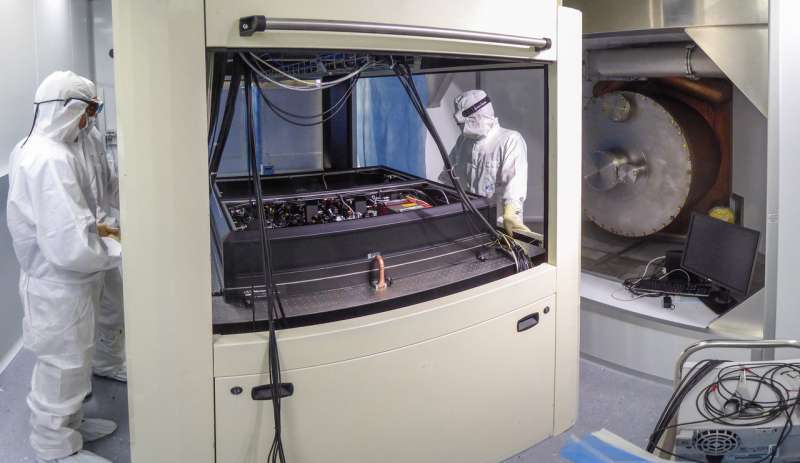Squeezed-light source to make gravitational wave detector even more sensitive

A team of researchers from the Max Planck Institute for Gravitational Physics (Albert Einstein Institute; AEI) in Hannover and from the Institute for Gravitational Physics at Leibniz Universität Hannover has developed an advanced squeezed-light source for the gravitational-wave detector Virgo near Pisa. Now, the Hannover scientists have delivered the setup, installed it, and handed it over to their Virgo colleagues. Beginning in autumn 2018 Virgo will use the squeezed-light source to listen to Einstein's gravitational waves together with the worldwide network of detectors with higher sensitivity than ever before.
"The German-British gravitational-wave detector GEO600 near Hannover has been routinely using a squeezed-light source since 2010. It has increased the part of the Universe that GEO600 listens to by a factor of up to four," says Prof. Karsten Danzmann, director at the AEI Hannover and director of the Institute for Gravitational Physics at Leibniz Universität Hannover. "The development and perfection of the cutting-edge technology is another successful chapter in the history of GEO600 as think thank of gravitational-wave research."
Both US LIGO instruments and the Virgo detector based in Tuscany are currently being upgraded and improved in preparation of the next joint observation run "O3" which is planned to commence in autumn 2018.
O3 is expected to usher in full-scale gravitational-wave astronomy through a large number of further gravitational-wave detections from merging binary black holes and additional signals from merging neutron star pairs.
For this purpose, Virgo has now received a valuable addition from Hannover: A setup called a squeezed-light source is expected to significantly increase Virgo's sensitivity from the beginning of O3. The custom-made device is a permanent loan of the AEI to Virgo and is worth about 400,000 Euros.
The sensitivity of all interferometric gravitational-wave detectors (LIGO, Virgo, and GEO600) to the ripples of space-time from large cosmic events is fundamentally limited by quantum mechanical effects. They cause a background noise which overlaps with the gravitational-wave signal that is measured with laser light.
"This background noise is present even in complete darkness and can never be entirely removed. But we can change its properties – we call that squeezing – such that it interferes less with the gravitational-wave measurement," say Dr. Henning Vahlbruch and Dr. Moritz Mehmet from AEI Hannover. They have built and the squeezed-light source and installed it at the Virgo detector. "In a sense, our device creates a kind of darkness that is better than nature usually allows for. With this improved background noise we can increase the detectors' sensitivity."
The sensitivity of all interferometric gravitational-wave detectors can only be further increased in the future through the use of similar squeezed-light sources. Planned third-generation detectors like the Einstein Telescope will also depend on this technology.
Provided by Max Planck Society




















